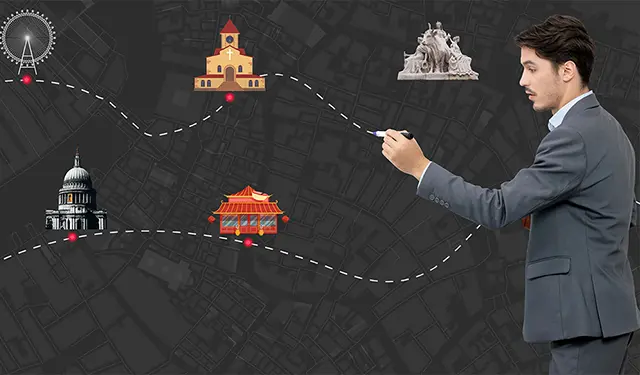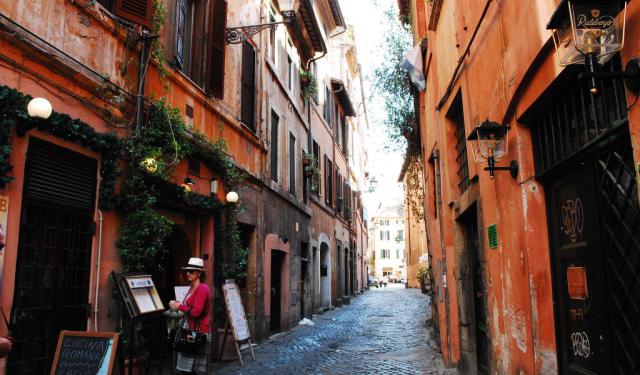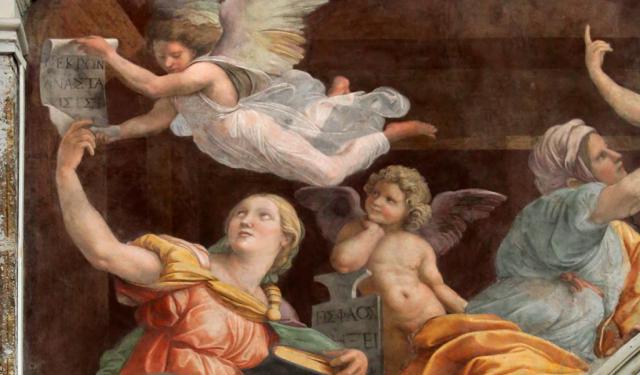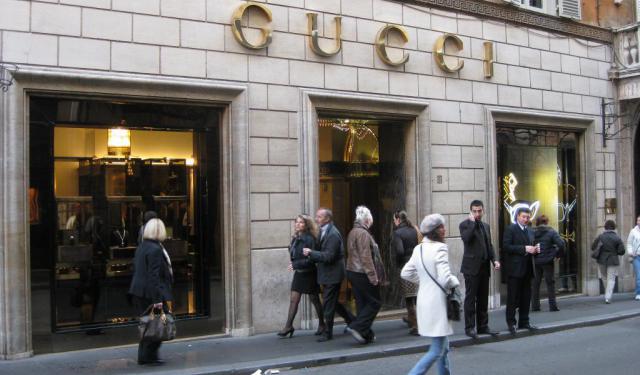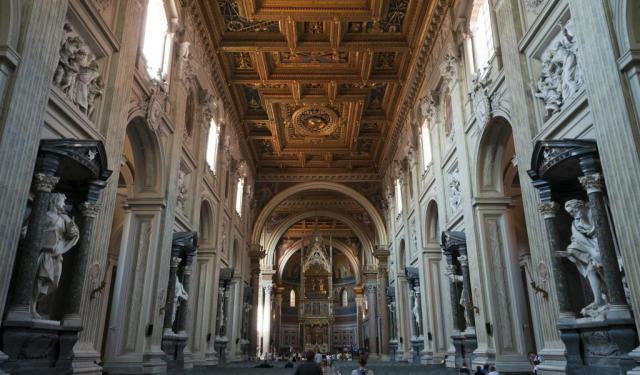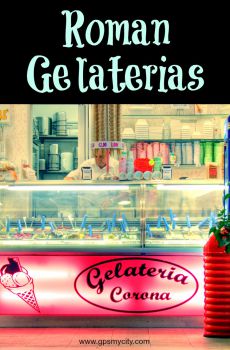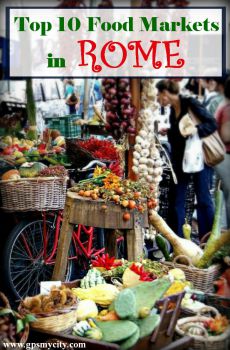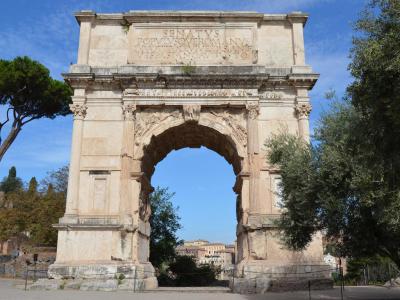
Arco di Tito (Arch of Titus), Rome
The Arch of Titus, an honorific arch on the Sacred Street, was built by Emperor Domitian around 81 AD. Its purpose was to commemorate Domitian's brother Titus’ victory in Judaea (which is modern-day Israel and Palestine) and his subsequent deification. The arch celebrates the Roman triumph over the Jewish revolt (also known as the Great Revolt), which resulted in the fall of Jerusalem in 70 AD. This victory brought over 60,000 Jewish slaves and immense wealth back to Rome, funding the construction of the Colosseum.
One of the only three surviving arches out of Rome’s original 36, the Arch of Titus provides a rare visual representation of the Roman triumphal procession of 71 AD. It also portrays Titus on horseback, symbolizing Rome’s dominance, and the Eagle, a representation of Roman power.
The Roman treatment of conquered people varied. Those who surrendered quickly were often incorporated into Roman society, while those who resisted fiercely—as in Judaea—faced brutal consequences such as mass slaughter, enslavement, and destruction of homes and livelihoods. The Jewish rebellion was crushed after the Romans breached three walls of Jerusalem over seven months, leading to one of the most devastating sackings of antiquity.
The arch's panels vividly depict scenes from this momentous event, offering one of the few contemporary representations of artifacts from Herod's Temple including the menorah, a multi-branched candelabra, used in the religious rituals of Judaism. While not explicitly mentioned, the panels closely mirror the narrative of the Roman procession described a decade earlier in the book titled "The Jewish War" written by Josephus, a first-century Roman-Jewish historian.
Beyond its historical importance, the Arch of Titus showcases a significant evolution in Roman art. The reliefs inside demonstrate early illusionistic techniques, giving a sense of depth and motion, a precursor to Baroque aesthetics nearly 1,500 years later. These artistic innovations highlight the stark contrast between the flourishing Roman Empire and the struggling tribes of northern Europe, who at the time still lived in primitive conditions.
As such, the arch had a long-lasting architectural influence, serving as a model for later triumphal arches, including the Arch of Triumph in Paris. Although the identity of its architect is uncertain, Rabirius, a favored designer of Emperor Domitian, is often suggested.
For Jewish communities, the arch remains a symbol of the diaspora. The menorah relief, a significant Jewish artifact depicted on the arch, later inspired the official emblem of the State of Israel. Today, the Arch of Titus is a must-see monument in Rome, linking the ancient past to modern history and symbolizing both Roman power and Jewish resilience.
One of the only three surviving arches out of Rome’s original 36, the Arch of Titus provides a rare visual representation of the Roman triumphal procession of 71 AD. It also portrays Titus on horseback, symbolizing Rome’s dominance, and the Eagle, a representation of Roman power.
The Roman treatment of conquered people varied. Those who surrendered quickly were often incorporated into Roman society, while those who resisted fiercely—as in Judaea—faced brutal consequences such as mass slaughter, enslavement, and destruction of homes and livelihoods. The Jewish rebellion was crushed after the Romans breached three walls of Jerusalem over seven months, leading to one of the most devastating sackings of antiquity.
The arch's panels vividly depict scenes from this momentous event, offering one of the few contemporary representations of artifacts from Herod's Temple including the menorah, a multi-branched candelabra, used in the religious rituals of Judaism. While not explicitly mentioned, the panels closely mirror the narrative of the Roman procession described a decade earlier in the book titled "The Jewish War" written by Josephus, a first-century Roman-Jewish historian.
Beyond its historical importance, the Arch of Titus showcases a significant evolution in Roman art. The reliefs inside demonstrate early illusionistic techniques, giving a sense of depth and motion, a precursor to Baroque aesthetics nearly 1,500 years later. These artistic innovations highlight the stark contrast between the flourishing Roman Empire and the struggling tribes of northern Europe, who at the time still lived in primitive conditions.
As such, the arch had a long-lasting architectural influence, serving as a model for later triumphal arches, including the Arch of Triumph in Paris. Although the identity of its architect is uncertain, Rabirius, a favored designer of Emperor Domitian, is often suggested.
For Jewish communities, the arch remains a symbol of the diaspora. The menorah relief, a significant Jewish artifact depicted on the arch, later inspired the official emblem of the State of Israel. Today, the Arch of Titus is a must-see monument in Rome, linking the ancient past to modern history and symbolizing both Roman power and Jewish resilience.
Want to visit this sight? Check out these Self-Guided Walking Tours in Rome. Alternatively, you can download the mobile app "GPSmyCity: Walks in 1K+ Cities" from Apple App Store or Google Play Store. The app turns your mobile device to a personal tour guide and it works offline, so no data plan is needed when traveling abroad.
Arco di Tito (Arch of Titus) on Map
Sight Name: Arco di Tito (Arch of Titus)
Sight Location: Rome, Italy (See walking tours in Rome)
Sight Type: Attraction/Landmark
Guide(s) Containing This Sight:
Sight Location: Rome, Italy (See walking tours in Rome)
Sight Type: Attraction/Landmark
Guide(s) Containing This Sight:
Walking Tours in Rome, Italy
Create Your Own Walk in Rome
Creating your own self-guided walk in Rome is easy and fun. Choose the city attractions that you want to see and a walk route map will be created just for you. You can even set your hotel as the start point of the walk.
Trastevere Walking Tour
Heading down from the Vatican along the River Tiber, one is bound to find yet another city hidden within the city – Trastevere. This name translates literally to "across the Tiber". Indeed, crossing the picturesque Ponte Sisto (Sisto Bridge) to the west bank, you will find yourself in a charming neighborhood with a distinct character that sets it apart from any other part of Rome.
... view more
Tour Duration: 2 Hour(s)
Travel Distance: 2.9 Km or 1.8 Miles
... view more
Tour Duration: 2 Hour(s)
Travel Distance: 2.9 Km or 1.8 Miles
Fountains and Squares Walking Tour
In Rome there is a lively piazza round almost every corner, each with its own unique atmosphere and its own story to tell. These public squares have been the center of Roman culture for centuries, and some of the city’s most popular attractions are located within them.
Most piazzas have a fountain in the center and a lot of cafes around. In fact, Rome holds the largest number of fountains in... view more
Tour Duration: 2 Hour(s)
Travel Distance: 4.1 Km or 2.5 Miles
Most piazzas have a fountain in the center and a lot of cafes around. In fact, Rome holds the largest number of fountains in... view more
Tour Duration: 2 Hour(s)
Travel Distance: 4.1 Km or 2.5 Miles
Hidden Art Treasures in Rome
Rome is one of the world's top living museums, replete with some of the most iconic pieces of art on the face of the planet. Famous artists, such as Michelangelo, Caravaggio, Raphael, Bernini, to mention but a few, had lived and worked here and left indelible marks in the city.
Needless to say that the abundance of masterpieces makes Rome crowded with tourists anxious to see them, causing... view more
Tour Duration: 2 Hour(s)
Travel Distance: 3.2 Km or 2 Miles
Needless to say that the abundance of masterpieces makes Rome crowded with tourists anxious to see them, causing... view more
Tour Duration: 2 Hour(s)
Travel Distance: 3.2 Km or 2 Miles
Rome Shopping Streets Walking Tour
Loved by tourists for its busy fashionable streets and significant baroque icons, the so-called ‘Tridente’ is one of the Eternal City's most lusted-after areas, formed by Via dei Condotti, Via Borgognona, Via Frattina and the adjacent Via del Corso. It is perhaps the most high-end destination for Roman shopping, with a concentration of renowned jewelers and important Italian/international... view more
Tour Duration: 2 Hour(s)
Travel Distance: 2.9 Km or 1.8 Miles
Tour Duration: 2 Hour(s)
Travel Distance: 2.9 Km or 1.8 Miles
Rome Introduction Walking Tour II
Rome, the Eternal City, carries a legacy shaped by centuries of resilience, transformation, and cultural flourishing. The fall of the Roman Empire in 476 AD marked the end of an era, plunging Western Europe into the dark Middle Ages. Yet, even amid the disarray, Rome endured as a beacon of unity, largely due to its status as the center of Catholicism. The papacy wielded spiritual influence,... view more
Tour Duration: 2 Hour(s)
Travel Distance: 3.4 Km or 2.1 Miles
Tour Duration: 2 Hour(s)
Travel Distance: 3.4 Km or 2.1 Miles
Holy Sites Walking Tour
As the cradle of the Catholic Church, one of the world's largest organizations, Rome has a large number of valuable, sacred places of worship. Crowded with architectural splendors from different periods of time, each of its churches and basilicas represent a significant part of culture and history.
Take this self-guided walking tour to discover Rome's magnificent religious heritage,... view more
Tour Duration: 3 Hour(s)
Travel Distance: 6.9 Km or 4.3 Miles
Take this self-guided walking tour to discover Rome's magnificent religious heritage,... view more
Tour Duration: 3 Hour(s)
Travel Distance: 6.9 Km or 4.3 Miles
Useful Travel Guides for Planning Your Trip
17 Best Gelaterias in Rome Italy
For ice cream lovers and dabblers this guide is a treasure chest of Rome’s best gelato shops. There are gelaterias everywhere. Many visitors to Rome only have a few days to explore the city. You owe it to yourself to make the most of your time and find the gelato locals eat. Often the authentic...
Souvenirs Shopping: 15 Authentic Italian Things To Buy in Rome
Rome is the Eternal City and, as such, the list of gift options available here is countless. Whether it's something edible, drinkable, wearable or pleasing to the eye that you want - you will find it all here in abundance. However, if time or budget is the factor, perhaps you might want to...
10 Best Food Markets in Rome Italy
Of all the things Italy is most famous for (cars, music, fashion, movies, etc.), food is, undoubtedly, top of the list. Rome may well not be the whole Italy, but no Italy is whole without Rome... And the Romans, much as all their fellow-Italians, like it "fresco", hence the abundance of...
